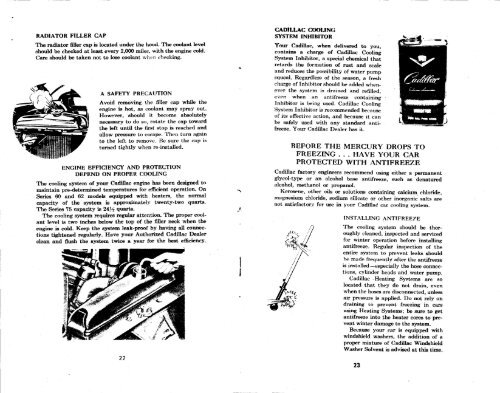1954 Cadillac - GM Heritage Center
1954 Cadillac - GM Heritage Center
1954 Cadillac - GM Heritage Center
You also want an ePaper? Increase the reach of your titles
YUMPU automatically turns print PDFs into web optimized ePapers that Google loves.
RADIATOR FILLER CAP<br />
The radiator filler cap is located under the hood. The coolant level<br />
should be checked at least every 2,000 miles, with the engine cold.<br />
Care should be taken not to lose coolant when chocking.<br />
A SAFETY PRECAUTION<br />
Avoid removing the filler cap while the<br />
engine is hot, as coolant may spray out.<br />
However, should it become absolutely<br />
necessary to do so, rotate the cap toward<br />
the left until the first stop is reached and<br />
allow pressure to escape. Then turn again<br />
to the left to remove. Be sure the cap is<br />
turned tightly when re-installed.<br />
ENGINE EFFICIENCY AND PROTECTION<br />
DEPEND ON PROPER COOLING<br />
The cooling system of your <strong>Cadillac</strong> engine has been designed to<br />
maintain pre-determined temperatures for efficient operation. On<br />
Series 60 and 62 models equipped with heaters, the normal<br />
capacity of the system is approximately twenty-two quarts.<br />
The Series 75 capacity is 24½ quarts.<br />
The cooling system requires regular attention. The proper coolant<br />
level is two inches below the top of the filler neck when the<br />
engine is cold. Keep the system leak-proof by having all connections<br />
tightened regularly. Have your Authorized <strong>Cadillac</strong> Dealer<br />
clean and flush the system twice a year for the best efficiency.<br />
22<br />
CADILLAC COOLING<br />
SYSTEM INHIBITOR<br />
Your <strong>Cadillac</strong>, when delivered to you,<br />
contains a charge of <strong>Cadillac</strong> Cooling<br />
System Inhibitor, a special chemical that<br />
retards the formation of rust and scale<br />
and reduces the possibility of water pump<br />
squeal. Regardless of the season, a fresh<br />
charge of Inhibitor should be added whenever<br />
the system is drained and refilled,<br />
even when an antifreeze containing<br />
Inhibitor is being used. <strong>Cadillac</strong> Cooling<br />
System Inhibitor is recommended because<br />
of its effective action, and because it can<br />
be safely used with any standard antifreeze.<br />
Your <strong>Cadillac</strong> Dealer has it.<br />
BEFORE THE MERCURY DROPS TO<br />
FREEZING . . . HAVE YOUR CAR<br />
PROTECTED WITH ANTIFREEZE<br />
<strong>Cadillac</strong> factory engineers recommend using either a permanent<br />
glycol-type or an alcohol base antifreeze, such as denatured<br />
alcohol, methanol or propanol.<br />
Kerosene, other oils or solutions containing calcium chloride,<br />
magnesium chloride, sodium silicate or other inorganic salts are<br />
not satisfactory for use in your <strong>Cadillac</strong> 1 car cooling system.<br />
INSTALLING ANT1FREE7E<br />
The cooling system should be thoroughly<br />
cleaned, inspected and serviced<br />
for winter operation before installing<br />
antifreeze. Regular inspection of the<br />
entire system to prevent leaks should<br />
be made frequently after the antifreeze<br />
is installed —especially the hose connections,<br />
cylinder heads and water pump.<br />
<strong>Cadillac</strong> Heating Systems are so<br />
located that they do not drain, even<br />
when the hoses are disconnected, unless<br />
air pressure is applied. Do not rely on<br />
draining to prevent freezing in cars<br />
using Heating Systems; be sure to get<br />
antifreeze into the heater cores to prevent<br />
winter damage to the system.<br />
Because your car is equipped with<br />
windshield washers, the addition of a<br />
proper mixture of <strong>Cadillac</strong> Windshield<br />
Washer Solvent is advised at this time.<br />
23

















